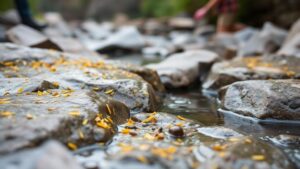Techniques for Identifying Hidden Placer Deposits in Mountain Streams
Techniques for Identifying Hidden Placer Deposits in Mountain Streams
Placer deposits represent an important resource for mineral recovery, particularly the extraction of gold and other precious metals. Often found in mountain streams and riverbeds, these deposits can be hidden beneath sand, gravel, or silt. Successful identification and extraction of these resources require a combination of geological knowledge, field techniques, and modern technology. This article explores the key techniques to uncover hidden placer deposits in mountainous stream environments.
Understanding Placer Deposits
Placer deposits are concentrations of valuable minerals formed by the mechanical weathering of rocks. This phenomenon occurs as minerals are eroded from their primary sources and transported by water, accumulating in stream beds. The most common placer minerals include:
- Gold
- Platinum
- Diamonds
- Heavy minerals like ilmenite and zircon
Identifying these deposits in mountain streams requires an understanding of the geology and hydraulic processes at play. Various techniques can enhance the likelihood of discovering these hidden treasures.
Field Techniques for Identification
1. Geological Mapping
Comprehensive geological mapping is a foundational technique for identifying potential placer deposits. By analyzing maps and geological surveys, prospectors can observe the types of rocks and formations in a mountain streams watershed. Look for:
- Areas with known parent rock sources
- Geological structures that facilitate mineral transport
- Historic placer mining locations
For example, areas near granitic or volcanic terrain are often promising due to the erosion of these rocks, which can lead to the release of gold particles into the stream.
2. Stream Sediment Sampling
Collecting and analyzing sediment samples from various locations within a stream can provide valuable insights into the presence of placer deposits. Key considerations when sampling include:
- Collect sediments from active channels, gravel bars, and behind boulders where gold is likely to concentrate.
- Use standard sampling tools like a pan or a sluice box to help separate heavy minerals.
A case study in the Yukon Territory demonstrated that systematic sediment sampling in prospective sites led to the discovery of significant gold concentrations, underscoring the effectiveness of this technique.
3. Hydraulic and Magnetic Surveys
Advancements in technology have bolstered traditional methods. Hydraulic surveys can be employed to analyze water flow and sediment transport, while magnetic surveys can identify heavy mineral concentrations. These techniques can aid in pinpointing areas with a high likelihood of hidden placer deposits.
- Hydraulic models assess the velocity of water and sediment movement.
- Magnetic surveys leverage the differences in magnetic susceptibility between gold and its surrounding materials.
The use of such surveys can significantly increase the efficiency of locating deposits, particularly in complex geological settings.
Environmental Considerations
When exploring for placer deposits, particularly in sensitive mountain ecosystems, environmental stewardship is crucial. Useing responsible mining practices and adhering to regulatory guidelines not only preserves the landscape but also ensures compliance with environmental laws. This includes:
- Minimizing disruption to the streambed and surrounding habitats.
- Obtaining appropriate permits and conducting environmental impact assessments.
Real-World Applications and Takeaways
Identifying hidden placer deposits in mountain streams requires a blend of traditional field methods and modern technological innovations. By utilizing geological mapping, sediment sampling, and advanced surveys, prospectors can significantly enhance their chances of locating lucrative deposits while maintaining environmental integrity.
Ultimately, a successful exploration effort relies on a comprehensive understanding of both geological principles and responsible mining techniques. As the demand for precious minerals continues to rise, mastering these identification techniques will be critical for both new and experienced prospectors.


